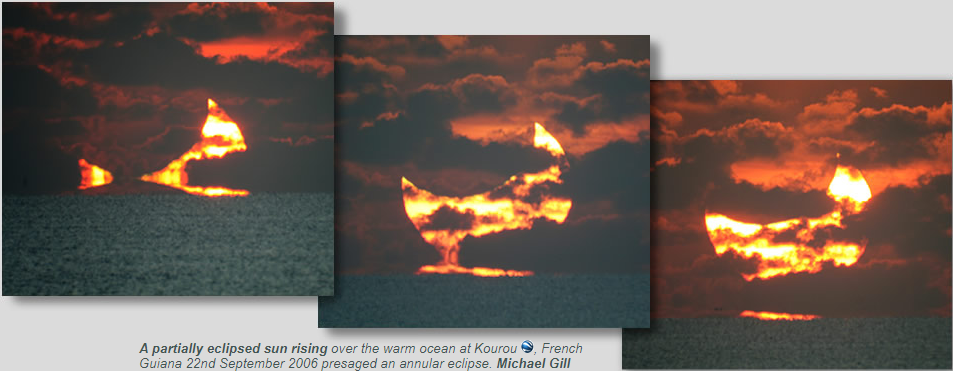Eclipsed "Omega" Sunrise
Eclipsed "Omega" Sunrise: A Captivating Atmospheric Phenomenon
Have you ever witnessed a sunrise that seemed out of this world? Imagine a partially eclipsed sun rising above the warm ocean, casting an enchanting glow over the horizon. This mesmerizing event occurred on September 22nd, 2006, in Kourou, French Guiana. Michael Gill, an avid observer of celestial events, traveled all the way from Birmingham, England to witness this extraordinary spectacle. He captured a stunning photograph of an eclipsed "Omega" sunrise, providing remarkable evidence of the inverted lower image in the mirage. Let's delve deeper into this captivating atmospheric optics phenomenon and unravel its mysteries.
When Michael Gill stood on a coastal bluff just a few meters above sea level, he became privy to a unique spectacle brought about by the residual warmth of the ocean. The heat created a layer of air immediately above the water, resulting in an inferior mirage or what is often referred to as an "Omega" sunrise. This mirage occurs when light rays passing through layers of air with varying densities are bent, creating an illusionary image.
The mirage mirror plane is situated close to the apparent horizon. If there were no atmospheric effects, the sunrise would have appeared as a typical sunrise on the left side of the diagram. However, below the mirror plane, the mirage produced a second inverted solar image. The combination of these two images resulted in the striking hour-glass silhouette on the sun, forming what is known as a "doubled eclipse." While sunspots sometimes indicate that slices of a miraged sunset are inverted, this phenomenon provides even more compelling proof.
As the sun continued to rise, it gradually transformed into a fully developed "Omega" or "Etruscan vase" shape. This metamorphosis added to the allure of the spectacle, leaving observers in awe of the celestial beauty unfolding before their eyes. The interplay of light and atmospheric conditions during this event created a visual feast, one that Michael Gill was fortunate enough to capture and share with the world.
Atmospheric optics phenomena, such as the eclipsed "Omega" sunrise, remind us of the incredible complexity and beauty of our natural world. These captivating events occur as a result of various factors coming together in perfect harmony. Let's explore some key elements that contribute to the creation of such mesmerizing optical illusions:
- Temperature Gradients: The temperature difference between layers of air can cause light rays to bend, leading to the formation of mirages.
- Refraction: The bending of light as it passes through layers of air with varying densities plays a crucial role in creating atmospheric optics phenomena.
- Inversion: The inversion of images in mirages occurs when light rays are bent in such a way that they create an illusionary image below the actual object.
- Atmospheric Effects: Factors such as humidity, air pressure, and the presence of aerosols can influence the appearance and intensity of atmospheric optics phenomena.
While the eclipsed "Omega" sunrise is undoubtedly a captivating sight to behold, it is just one example of the countless atmospheric optics phenomena that occur around the world. From dazzling sun halos to vibrant rainbows, our atmosphere never ceases to amaze us with its ability to create breathtaking displays of light and color.
As we continue to explore and understand the intricacies of atmospheric optics, we gain valuable insights into the workings of our atmosphere and its impact on the light that reaches us. These phenomena not only provide us with moments of awe and wonder but also serve as a reminder of the intricate interconnectedness of our natural world.
So, the next time you find yourself gazing at a picturesque sunrise or marveling at a rainbow after a storm, take a moment to appreciate the scientific marvels behind these captivating displays. The world of atmospheric optics is full of surprises, waiting to be discovered and admired by those with a curious mind and an appreciation for the beauty that surrounds us.

A partially eclipsed sun rising over the warm ocean at Kourou , French Guiana 22nd September 2006 presaged an annular eclipse. Michael Gill journeyed from Birmingham, England to see the event and caught this unusual eclipsed "Omega" sunrise and stunning proof that the lower image of the mirage really is inverted. Larger image. Image ©2006 Michael Gill
Michael was on a coastal bluff only a few metres above sea level. Residual warmth of the sea heated a layer of air immediately above it to produce the inferior mirage or 'Omega' sunrise.

The mirage mirror plane is close to the apparent horizon and the sunrise if unaffected by any atmospheric effects would have appeared as in the left hand figure of the diagram. Below the mirror plane, the mirage produced a second inverted solar image. The combined images produce the striking hour-glass silhouette on the sun. Sunspots sometimes indicate to us that slices of a miraged sunset are inverted but this 'doubled eclipse' is a more striking proof.
As the sun rose it took on the fully developed 'Omega' or 'Etruscan vase' shape
Note: this article has been automatically converted from the old site and may not appear as intended. You can find the original article here.
Reference Atmospheric Optics
If you use any of the definitions, information, or data presented on Atmospheric Optics, please copy the link or reference below to properly credit us as the reference source. Thank you!
-
<a href="https://atoptics.co.uk/blog/eclipsed-omega-sunrise/">Eclipsed "Omega" Sunrise</a>
-
"Eclipsed "Omega" Sunrise". Atmospheric Optics. Accessed on December 22, 2024. https://atoptics.co.uk/blog/eclipsed-omega-sunrise/.
-
"Eclipsed "Omega" Sunrise". Atmospheric Optics, https://atoptics.co.uk/blog/eclipsed-omega-sunrise/. Accessed 22 December, 2024
-
Eclipsed "Omega" Sunrise. Atmospheric Optics. Retrieved from https://atoptics.co.uk/blog/eclipsed-omega-sunrise/.